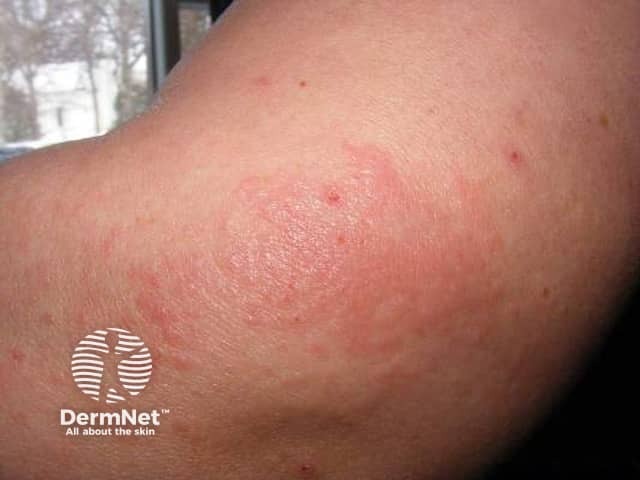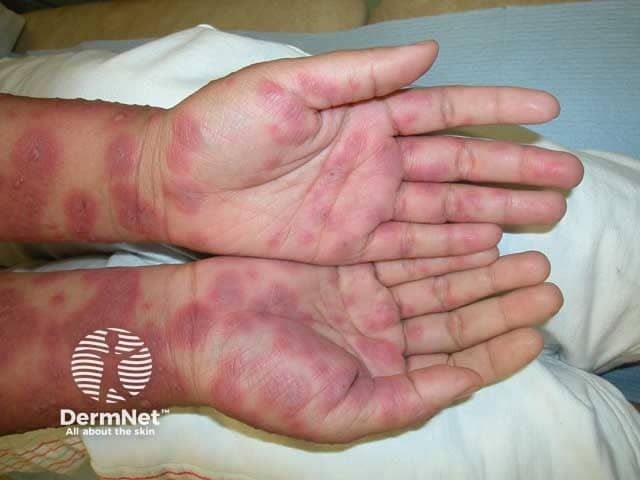Main menu
Common skin conditions

NEWS
Join DermNet PRO
Read more
Quick links
Autoimmune progesterone dermatitis — extra information
Autoimmune/autoinflammatory Rashes
Autoimmune progesterone dermatitis
Authors: Dr Kenneth Wong, Dermatology Registrar, Greenlane Hospital, Auckland, New Zealand, 2008; Updated: Dr Malini Sivasaththivel, Resident Medical Officer, Eastern Health, Melbourne, Australia; Dr Martin Keefe, Consultant Dermatologist, Christchurch, New Zealand. Copy edited by Gus Mitchell. October 2021
Introduction Demographics Causes Clinical features Complications Diagnosis Differential diagnoses Treatment Outcome
What is autoimmune progesterone dermatitis?
Autoimmune progesterone dermatitis is a rare, cyclical mucocutaneous hypersensitivity reaction to peak levels of endogenous progesterone seen in the luteal phase of the menstrual cycle.
Who gets autoimmune progesterone dermatitis?
Autoimmune progesterone dermatitis is predominantly a condition of young adult women with a mean age of onset of 27.3 years; it has also been reported in adolescents after the menarche and in older premenopausal women. It often, but not always, occurs in women who have previously received exogenous progestogens, such as the oral contraceptive pill or fertility treatments. It may present in pregnancy or the post-partum period. There is no genetic risk.
What causes autoimmune progesterone dermatitis?
The cause of autoimmune progesterone dermatitis is not known. Hypotheses include:
- Exogenous progestogens may trigger a type 1 (immediate) hypersensitivity reaction with the formation of progesterone-specific immunoglobulin E (IgE) antibodies and a mast cell-mediated response, which may target progesterone receptors expressed above the basal layer on keratinocytes.
- There may be a type 4 (delayed) hypersensitivity reaction to progestogens.
Sensitised patients then have cyclical symptoms due to an ongoing autoimmune response to the elevated levels of progesterone seen in the luteal phase of the menstrual cycle.
The cause in patients with no prior exposure to exogenous progestogens is unclear.
[see Allergies explained]
What are the clinical features of autoimmune progesterone dermatitis?
Autoimmune progesterone dermatitis characteristically presents as a rash that appears 3–4 days before menstruation when progesterone levels peak. The rash resolves within a few days after the onset of menstruation as progesterone levels reduce, only to recur just before the next period. This cyclical pattern may not be apparent in women with irregular menses.
The type of rash seen in autoimmune progesterone dermatitis can be variable, but the majority of patients present with:
- Urticaria +/- angioedema and anaphylaxis
- Dermatitis.
Other reported eruptions include:
- Non-specific skin changes — morbilliform rash, papules and plaques, vesiculobullous and vesiculopustular lesions, petechiae, and purpura
- Fixed drug eruption
- Cyclic vulvovaginitis
- Stomatitis
- Erythema multiforme
- Annular erythema
- Necrolytic migratory erythema–like eruption.
Skin changes typically affect the trunk and limbs but may involve the face, oral mucosa, lips, and genitalia.

Autoimmune progesterone dermatitis: dermatitis presentation

Autoimmune progesterone dermatitis: erythema mulitiforme pattern

Autoimmune progesterone dermatitis: urticarial pattern
What are the complications of autoimmune progesterone dermatitis?
- Spontaneous abortion has been reported
How is autoimmune progesterone dermatitis diagnosed?
Autoimmune progesterone dermatitis should be considered if:
- There is a consistent and recurring premenstrual flare of a rash
- The rash is reproducible following intramuscular progesterone injection — oral or intravaginal challenge tests may be alternatives
- The rash can be prevented by suppression of ovulation.
Intradermal tests with progesterone can be performed and may trigger local or systemic reactions. However, suitable reagents may be difficult to source, the tests are not standardised, and irritant reactions may occur.
Other tests not routinely available include lymphocyte transformation tests, interferon gamma release assay, and demonstration of progesterone-specific IgE on ELISA.
There are no diagnostic skin biopsy findings that distinguish disease triggered by progesterone from other aetiologies.
What is the differential diagnosis for autoimmune progesterone dermatitis?
- Drug eruption
- Spontaneous urticaria
- Atopic dermatitis or other dermatoses that can flare premenstrually
- Oestrogen dermatitis
What is the treatment for autoimmune progesterone dermatitis?
General measures
Specific treatments
- Oral contraceptive pill
- Gonadotrophin releasing hormones
- Tamoxifen
- Oophorectomy
- Progesterone desensitisation by injection or intravaginal topical application
What is the outcome for autoimmune progesterone dermatitis?
Autoimmune progesterone dermatitis continues unabated without treatment. Response to treatment is variable. Some women experience a reduction in symptoms during pregnancy which is thought to be due to a natural desensitisation process that occurs with the gradual increase in progesterone during pregnancy; others experience a worsening of symptoms during pregnancy. Autoimmune progesterone dermatitis resolves at menopause and progesterone-containing hormone replacement therapy should not be prescribed.
Bibliography
- Afra TP, Razmi T M, Thoyyib M, et al. Autoimmune progesterone dermatitis as a clue to refractory jaundice in a young woman. Clin Exp Dermatol. 2021;46(1):163–4. doi:10.1111/ced.14332. PubMed
- Aghazadeh N, Chattha AJ, Hartz MF, Davis DMR. Autoimmune progesterone dermatitis in the adolescent population. Pediatr Dermatol. 2021;38(2):380–4. doi:10.1111/pde.14423. PubMed
- Brown H, Relic J. Autoimmune progesterone dermatitis presenting as recurrent, marked angioedema-like lip changes: an unusual presentation of an uncommon problem. Australas J Dermatol. 2020;61(3):261–2. doi:10.1111/ajd.13297. PubMed
- Geros H, Maor D, Higgins C, Bala HR, Nixon R. Intradermal testing for autoimmune progesterone dermatitis: should we be basing the diagnosis on it? Clin Exp Dermatol. 2021;46(5):906–9. doi:10.1111/ced.14664. PubMed
- Le K, Wood G. A case of autoimmune progesterone dermatitis diagnosed by progesterone pessary. Australas J Dermatol. 2011;52(2):139–41. doi:10.1111/j.1440-0960.2011.00753.x. PubMed
- Nguyen T, Razzaque Ahmed A. Autoimmune progesterone dermatitis: update and insights. Autoimmun Rev. 2016;15(2):191–7. doi:10.1016/j.autrev.2015.11.003. PubMed
- Varghese A, Paul T, Kim H, Van Uum S, Vadas P, Azzola A. Effect of omalizumab for autoimmune progesterone dermatitis refractory to bilateral oophorectomy: a case report. Allergy Asthma Clin Immunol. 2021;17(1):58. doi:10.1186/s13223-021-00561-2. Journal
- Warin AP. Case 2. Diagnosis: erythema multiforme as a presentation of autoimmune progesterone dermatitis. Clin Exp Dermatol. 2001;26(1):107-8. doi:10.1046/j.1365-2230.2001.00747.x. PubMed
- Zhang M, Tang X, Zhou H, Liao Q, Han J. Case of autoimmune progesterone dermatitis presenting as necrotic migratory erythema successfully controlled by danazol. J Dermatol. 2020;47(2):178–80. doi:10.1111/1346-8138.15180. PubMed
On DermNet
Books about skin diseases
